Hydrogeological situation on 1 February 2024
In January 2024, the levels of inertial aquifers continued to rise. However, the recharge slowed or even stopped in many reactive aquifers.
The state of the aquifers was satisfactory over a large part of France, particularly in the reactive aquifers, due to abundant rainfall at the beginning of the recharge period. It was less satisfactory in the inertial aquifers in the Sundgau and Saône corridor and in the south and south-eastern regions, as well as in Corsica, which had low to very low levels.
The trends and developments during this winter will depend primarily on the amount of rainfall. The generally positive start to the winter recharge period means we can expect satisfactory levels across much of France at the end of winter. However, if there is insufficient rainfall by the end of this winter, the state of the reactive aquifers could rapidly deteriorate, and the state of the inertial aquifers could also worsen, but at a slower rate. The state of the aquifers in the south-east of France needs to be closely monitored, since they remain particularly vulnerable due to severe low-water periods over recent years and the lack of any significant recharge episodes.
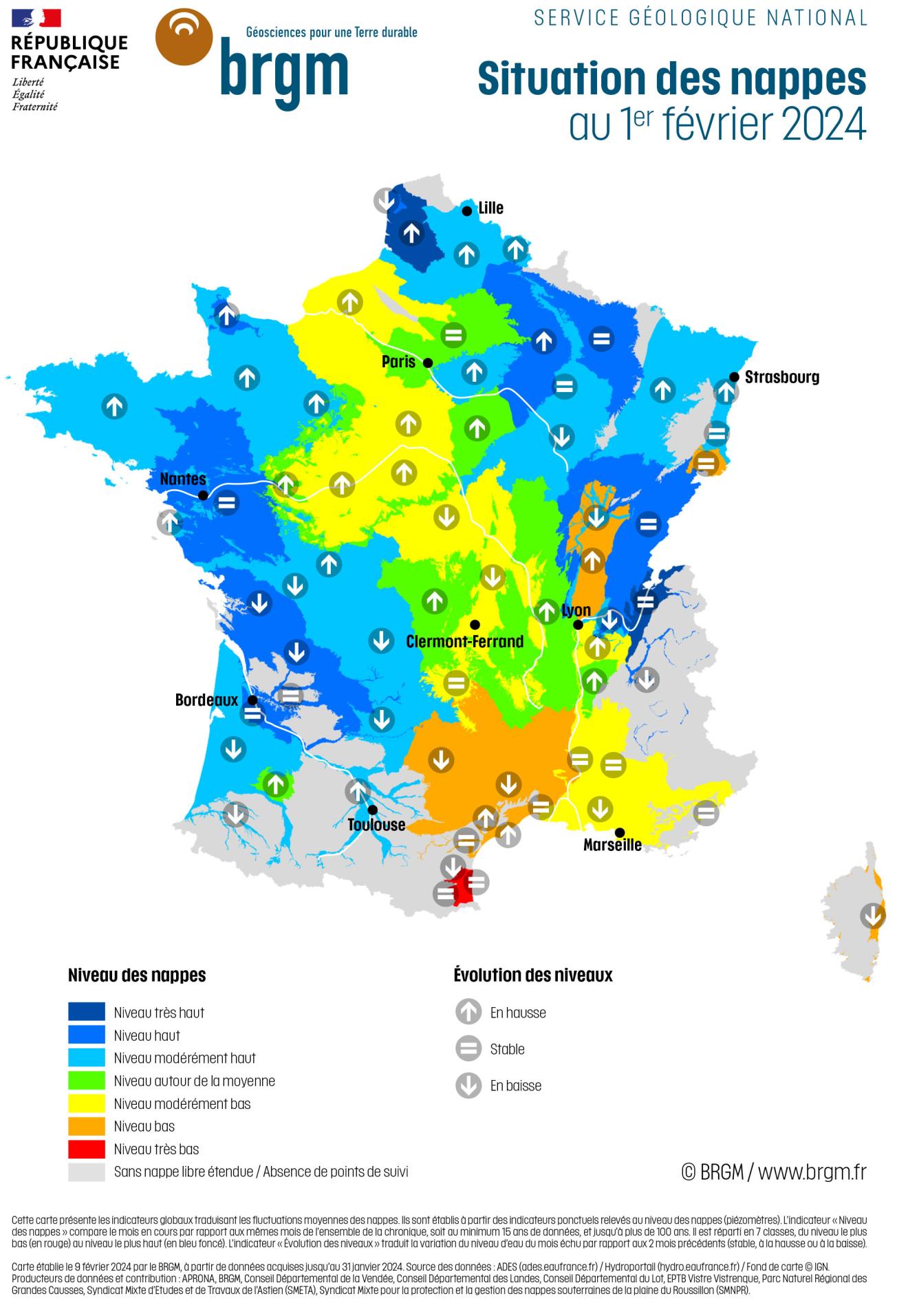
Map of aquifer levels in mainland France on 1 February 2024.
© BRGM
Groundwater trends
In 2023, the groundwater depletion period ended particularly late in the year, due to insufficient rainfall and the fact that the vegetation remained active at the beginning of autumn due to the warm temperatures. The recharge began at the end of October and remained extremely active in November and December.
In January 2024, the aquifer recharge continued, although the rate slowed across a large part of the country. Higher levels were recorded at 51% of observation points (as opposed to 69% in November).
The trends in the reactive water tables in the northern two-thirds and south-west of the country were variable, depending on the amount of rainfall recorded in January. In the areas that received little rain, the lack of significant rainfall had rapid consequences. The upward trends noted in January were reversed, with water levels falling in many areas. Where the amount of rainfall infiltration was enough to compensate for the depletion of the aquifers towards their natural outlets (springs, rivers, sea, etc.), then the recharge continued in January. Consequently, the levels remained stable or rose in the aquifers in the Armorican Massif, the Greater-eastern region of France and in the north of the Massif Central, notably.
The levels in most inertial and semi-inertial aquifers continued to rise in January 2024. The inertia of these aquifers means that it takes several weeks for rainfall to filter through the unsaturated zone. The increase in the levels recorded in January were therefore due to the effective rainfall that infiltrated into the ground during November and December.
Finally, around the Mediterranean coast and in Corsica, the aquifer levels generally decreased or, at best, remained stable. The total rainfall over the last few weeks failed to halt the downward trend. In January, even though certain brief increases in the levels temporarily interrupted the depletion, this had little impact on the monthly trends.
Comparison between 1 February 2023 and 1 February 2024
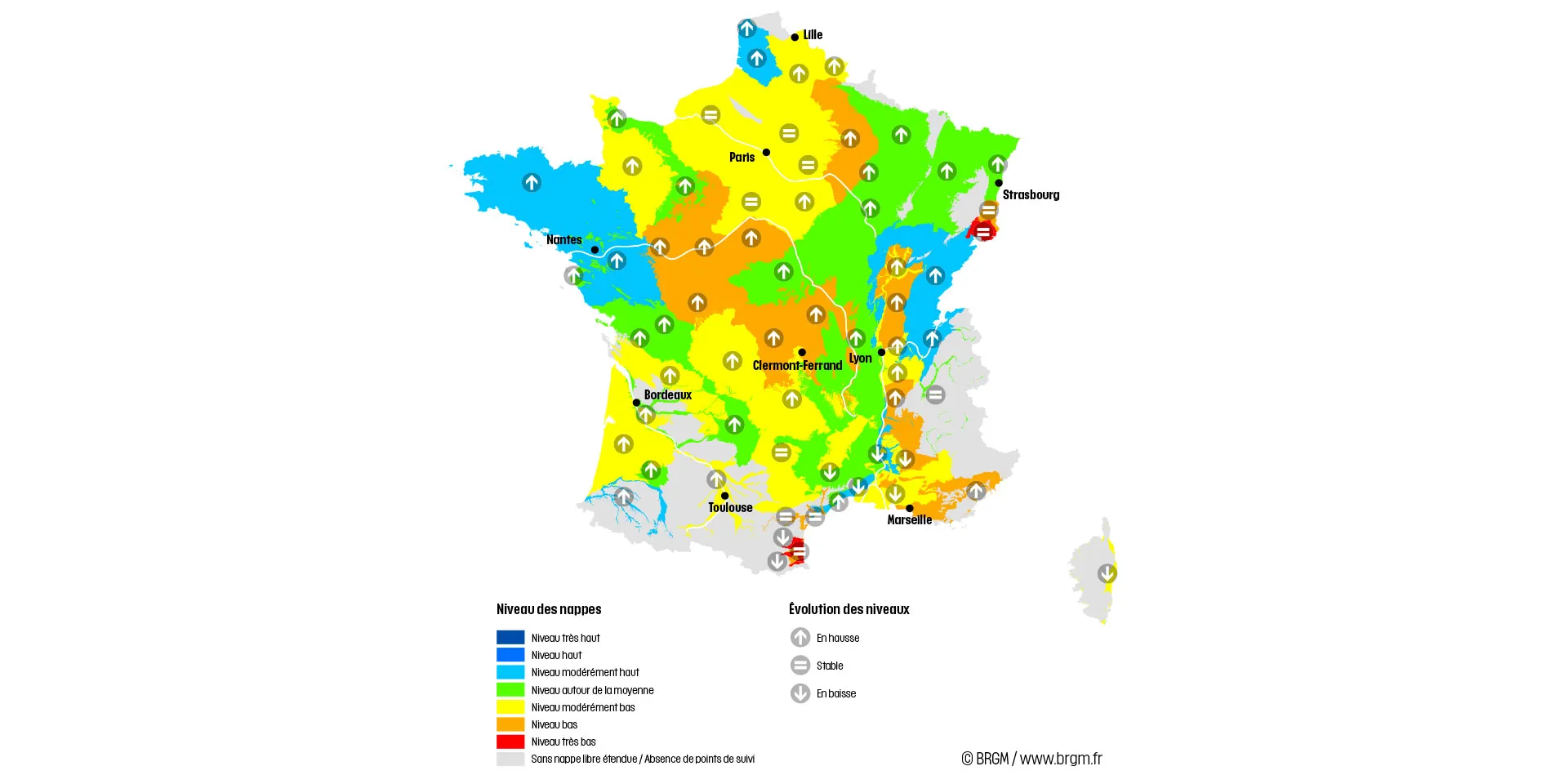
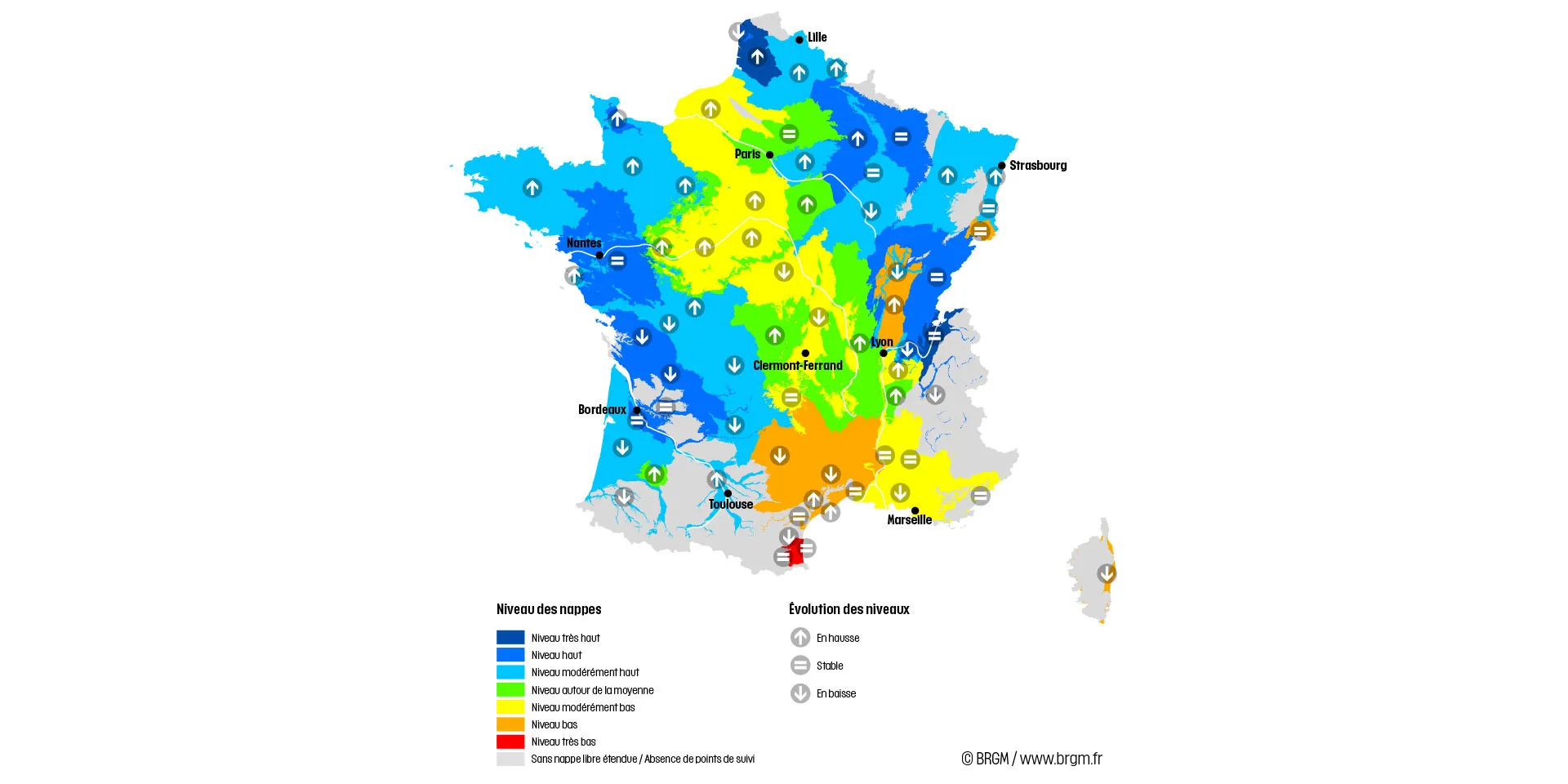
Map of France showing the state of the aquifers on 1 February 2023 (left) and 1 February 2024 (right).
© BRGM
The groundwater situation
The groundwater situation during the low-water period in 2023 was unsatisfactory, with aquifer levels being generally below normal monthly levels. The significant recharge that occurred between the end of October and December had a marked effect on the aquifers. The overall situation has improved considerably, particularly in the reactive aquifers in the northern two-thirds of France and in the south-west.
However, in January, the rate of the recharge decreased. The situation remained satisfactory overall, although it deteriorated slightly: The levels recorded at 39% of the observation points were below monthly averages, 15% were comparable with monthly norms and 46% were above average (compared with 36%, 8% and 56% in December, respectively). The situation was more positive than that observed for the previous year, in January 2023, when 60% of the levels recorded were below monthly averages. In January 2024, only the aquifers in the Languedoc, Roussillon and Corsica had levels that were lower than those recorded in January 2023.
The state of aquifers in January 2024 remained variable across the country, ranging from very low to very high levels. The levels were satisfactory in the west (from the Cotentin to the Haute-Garonne region) and in the north-east (from the Artois region to the valleys of the Alps), ranging from moderately high to very high. The levels were moderately low or comparable with monthly averages over the central area of the country stretching from Normandy to Auvergne. Finally, the levels were less satisfactory in the south-east, ranging from moderately low to very low. The reasons for these variable situations are essentially linked to how responsive the different aquifers are to rainfall and how intense the start of the 2023-2024 recharge period was in the different parts of the country.
In the reactive and semi-inertial aquifers in the northern two-thirds and south-west of France, the rainfall that had been filtering through the ground since mid-October helped to improve the situation. However, insufficient rainfall in January led to a deterioration in water levels. Nonetheless, the state of these aquifers remained satisfactory, ranging from moderately high to high. The levels were even very high in the semi-inertial chalk aquifer on the Artois-Picardie coast. Only the aquifers in the central and northern parts of the Massif Central had an insufficient recharge, with their levels ranging from close to average to moderately low.
The situation in inertial aquifers is evolving very slowly. The levels were moderately high to moderately low in the Paris Basin, with more favourable situations in the north, the east and in certain coastal areas. On a local level, the central-western part of the Paris Basin remained in a poor state, with moderately low to very low levels (to the east of the Normandy chalk aquifer and to the west of the Beauce aquifer). In eastern France, the state of the aquifers has improved slowly since the autumn. The aquifers in the Sundgau (southern Alsace) and the Saône corridor remain low. The aquifers in the Rhône corridor ranged from moderately low to comparable-with-monthly-norms, but the situations were variable depending on the location. Finally, high to very high levels were recorded in the Artois and Picard Plateau chalk aquifers and in the Savoie foothills, due to significant recharges in recent weeks and the fact that the low water period in 2023 was not particularly severe. It should be noted that these high levels could contribute to episodes of flooding.
In the south-east (southern Massif Central, the Cévennes, the Mediterranean coast and Corsica), the lack of rainfall at the start of the 2023-2024 recharge period has had an impact on the aquifers. Their levels remain below average, ranging from moderately low to low. In certain localised areas the levels recorded were unsatisfactory, notably in the eastern Bouches-du-Rhône region, on the Var plains, along the Alpes-Maritimes coast, in the Languedoc region and in eastern Corsica. The water levels remain a cause for concern in the limestone aquifers of the Corbières massif and in the alluvial aquifers along the Roussillon coast.
Aquifers that are in a very good state
Several aquifers are in a very good state, with levels ranging from high to very high, in relation to the levels recorded for January in previous years:
- The high levels recorded in the Jurassic limestone aquifers of the Boulonnais region and in the Cenomanian chalk marl aquifers along the Artois-Picardie coast are due to the highly abundant recharge in 2022-2023 and the heavy rainfall at the end of October and in November 2023.
- The alluvial aquifer in the Savoie foothills benefited from the fact that the low-water period was not severe in 2023 and that it received more water than needed during the start of the recharge period.
- The heavy rainfall between mid-October and December had a positive effect on the chalk aquifers in Champagne, the Jurassic and Cretaceous limestone aquifers in Lorraine, Jura, Charentes, Périgord and the Angoumois basin, the basement aquifers in the south of the Armorican Massif, and the alluvial aquifers in the Alps, along the Dordogne and in the lower Garonne. The water levels were high in all these aquifers.
Aquifers in a poor state
Many aquifers were in a poor state, with low to very low levels compared to those recorded in January of previous years, due to an extreme lack of rainfall over the last few months or years:
- The situation is improving very slowly in the plioquaternary gravel inertial aquifers in the Sundgau area and the Dijonnais, Bresse and Dombes regions, but levels remained low due to poor recharges over several winters and the high degree of inertia with which rainfall filters through to these aquifers.
- The levels of the basement aquifers in the southern Massif Central, the karst limestone aquifers in the Grands Causses and the Cévennes regions, and in the formations along the Languedoc coast were low, due to a lack of significant recharge episodes during the autumn and early winter of 2023-2024.
- The water levels in the multi-layer aquifer in Roussillon and the karst limestone aquifer in the Corbières massif remain extremely poor (very low levels), due to a chronic lack of rainfall for more than a year. Certain observation points have recorded steadily-falling levels since May 2022, and have even reached historic lows.
How do aquifers fill up and how do they empty?
Groundwater levels vary throughout the year, from high levels in winter (when vegetation does not absorb rainwater) to low levels in summer (the traditional depletion period).
The fate of rainfall varies greatly depending on the time of year and the condition of the ground surface on which it falls. Usually, the groundwater-recharge period takes place from early autumn (September-October) to early spring (March-April), a six-month period during which vegetation is dormant (with low evapotranspiration) and rainfall is generally more abundant. If the winter is dry, groundwater recharge is very low.
From spring through summer, rising temperatures coupled with the regrowth of vegetation and thus increased evapotranspiration, limit the infiltration of rainfall into aquifers. Between May and October, unless there are exceptional rainfall episodes, aquifer depletion usually continues and levels will keep decreasing until the autumn.
Why do some aquifers recharge faster than others?
Groundwater flows at different rates depending on the porosity (percentage of gaps/cracks in the rock) and permeability (capacity to allow water to circulate, i.e. interconnectivity between these gaps/cracks) of the aquifers. The larger the gaps and the more interconnected they are, the faster the water will flow, for both refilling and depletion.
It takes a given volume of water different periods of time to travel the same distance, depending on the kind of rock formation:
- a few years in a porous formation,
- a few months in a cracked formation,
- and a few days, or even a few hours, in a karst formation.
Inertial and reactive aquifers: what are they?
The impact of the winter recharge varies according to the cyclic nature of the aquifer, i.e., its reactivity to rainfall infiltration.
We refer to aquifers that are:
- reactive (when they are composed of sand, gravel, karst limestone or weathered granite formations). These aquifers are characterised by their rapid reaction times: they can recharge during heavy summer rainfall, but are also highly sensitive to drought. Their levels can therefore vary very quickly over the course of the same season.
- inertial (when composed of chalk, non-karst limestone, sandstone formations). Their reaction times are slow. They can have multi-annual cycles, meaning that they require a long period to recharge or empty.

Cyclicity of aquifers in mainland France.
© BRGM
Forecasts
The Météo-France seasonal forecasts for February, March and April (2024) predict higher temperatures than usual across the whole of France. No clear scenario has been established concerning rainfall.
In view of the rainfall already observed and forecast for February 2024, the recharge should either resume or continue over a large part of the country. The groundwater situation should improve rapidly in areas with reactive aquifers that benefit from sustained recharge periods, whereas the improvement will be slower in areas with inertial aquifers or which receive less rainfall. In the event of significant accumulated rainfall, the most reactive aquifers (basement, karst limestone, alluvial) could experience sharp rises in water levels. However, if there is insufficient rainfall, the recharge will probably stall in reactive aquifers and the situations could then deteriorate more or less rapidly, depending on the area. After a dry month of January, the recharge in inertial aquifers could also slow and their levels could even drop.
In the longer term, the trends and changes in the state of the aquifers, with the resumption of vegetation growth in the spring, will depend entirely on the total accumulated rainfall. If there is insufficient precipitation, infiltrated rainfall will not compensate for the output volumes (natural outlets and abstractions). On the other hand, if there is enough rainfall, the recharge will continue.
In the inertial aquifers, the groundwater situation should evolve slowly. If there is a normal or surplus amount of rainfall between now and spring, many of the inertial aquifers should reach close-to-average levels. The forecasts are more pessimistic for the plioquaternary aquifers in the Sundgau, Dijon, Bresse and Dombes regions, unless there is very high rainfall over the coming months. The levels in these aquifers are expected to remain below normal monthly levels.
In the case of reactive aquifers, the forecast is not clear for the next few weeks and will depend on accumulated rainfall. Over a large part of the north and south-west of the country, the start of the winter recharge means that we can expect to see satisfactory levels at the end of winter. However, the situation could also deteriorate rapidly if there is insufficient rainfall towards the end of winter, in which case the levels in spring 2024 could be below normal. The groundwater levels in the summer of 2024 will depend on whether there is an abundant winter recharge, which continues into the spring. This would push back the start of the depletion period.
As regards the aquifers around the Mediterranean coast, the rainfall in February will probably have little impact on the groundwater levels. Any rain that falls after a long dry spell will initially serve to moisten the soil, before infiltrating deeper into the ground. In the event of heavy rainfall, we can expect certain periodic, temporary rises in groundwater levels, particularly in highly reactive, shallow or rapid-cycle karst aquifers. In the longer term, it will require sustained, well-distributed rainfall at the end of winter or in spring to help recharge the aquifers and thus generate satisfactory groundwater levels. The snowmelt in the spring will also have an impact on certain aquifers in Provence and the Côte d'Azur. However, it is difficult to imagine the aquifer reserves in the Roussillon region reaching above average levels by spring 2024 or being fully refilled on a long-term basis.
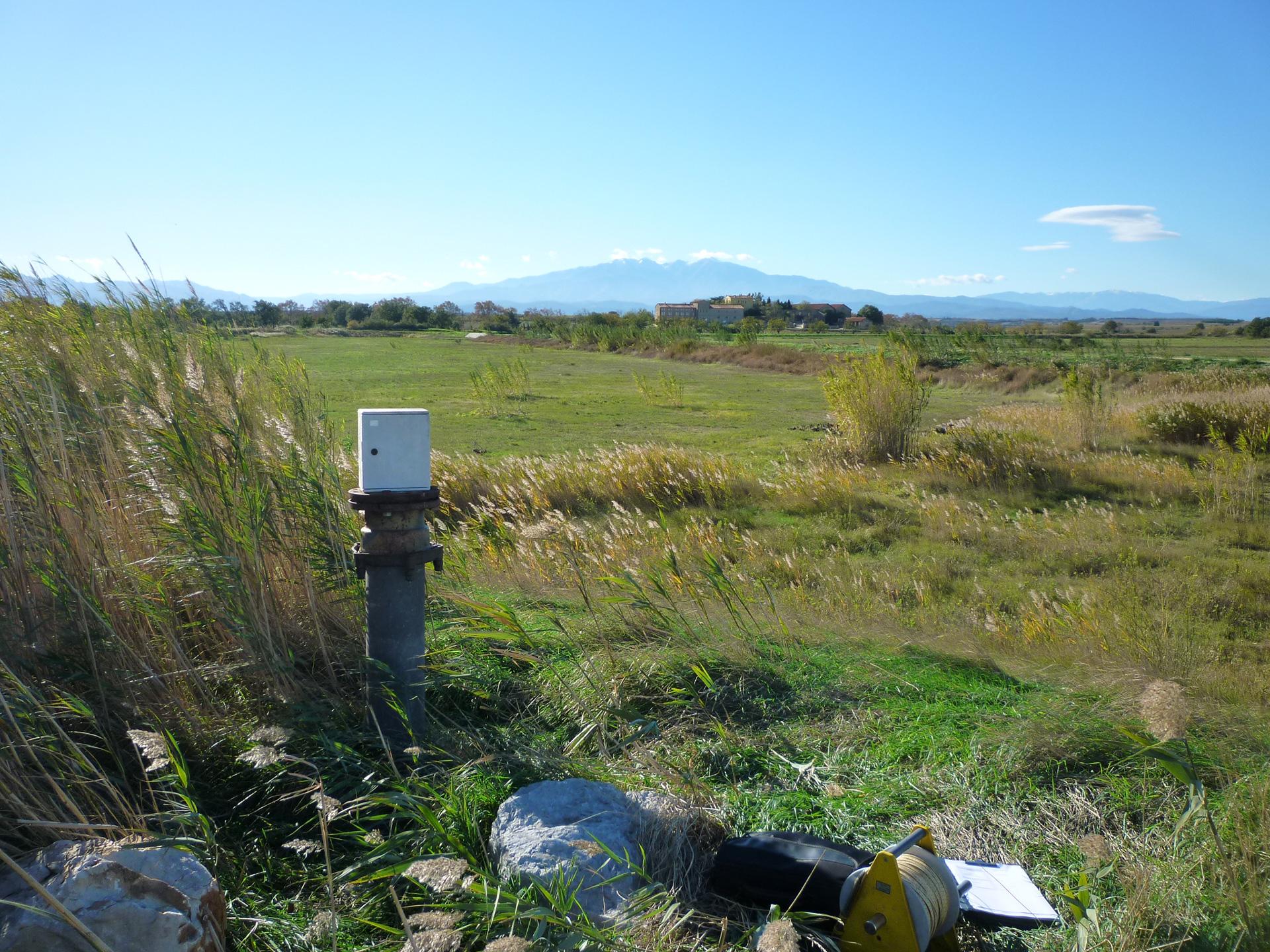
State of groundwater: monitoring by BRGM
Groundwater is a widely used resource: in metropolitan France, it accounts for nearly two-thirds of drinking water consumption and more than one-third of agricultural water consumption. It is also widely used in the industrial sector. Groundwater tables depend on cyclical recharges.
BRGM monitors groundwater levels and quality in mainland France. Discover the actions carried out by the French geological survey and the resources and databases available on groundwater in France.
Press contact


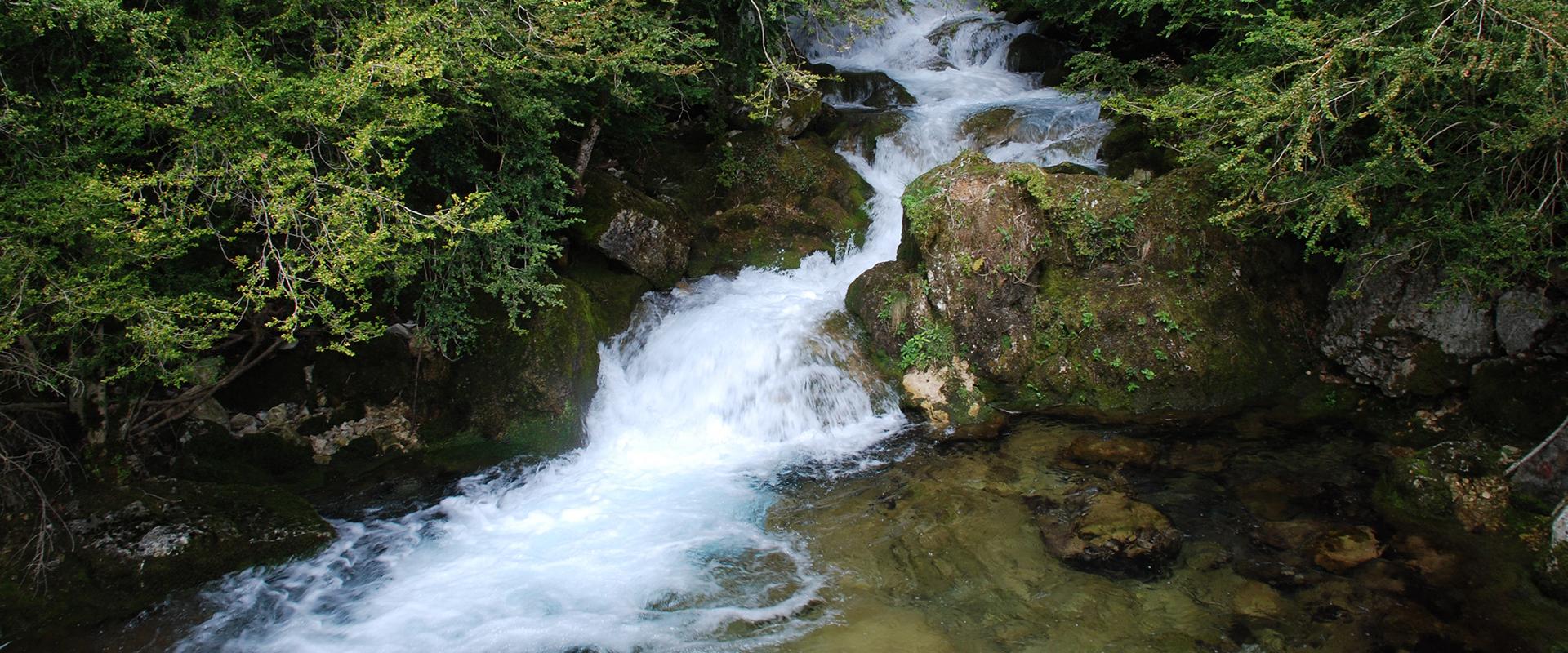
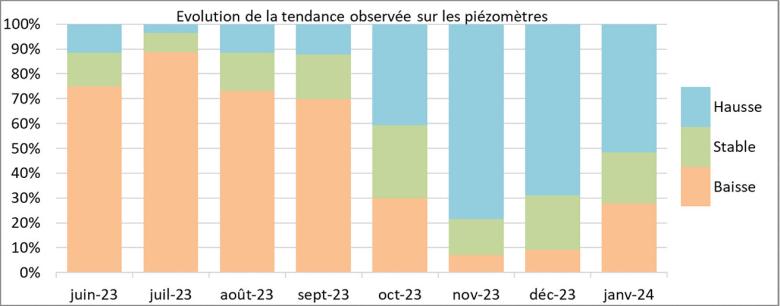
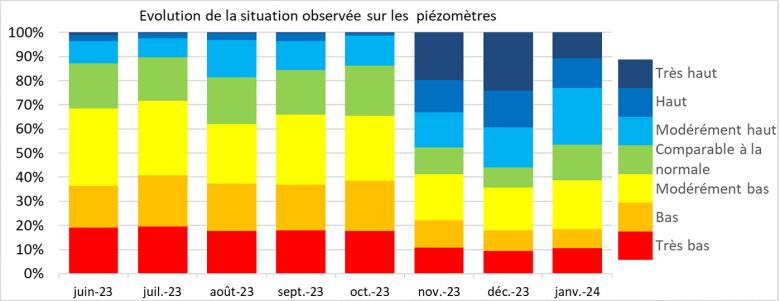




Map drawn up by BRGM on 9 February 2024, based on data from the ADES database, acquired up to 31 January 2024. Data source: ADES database (ades.eaufrance.fr) / Hydroportail (hydro.eaufrance.fr) / Background map © IGN. Data producers and contributors: APRONA, BRGM, Conseil Départemental de la Vendée, Conseil Départemental des Landes, Conseil Départemental du Lot, EPTB Vistre Vistrenque, Parc Naturel Régional des Grandes Causses, Syndicat Mixte d'Etudes et de Travaux de l'Astien (SMETA), Syndicat Mixte pour la protection et la gestion des nappes souterraines de la plaine du Roussillon (SMNPR).
This map shows the global indicators reflecting the average fluctuations of the aquifers. They are based on point indicators collected at groundwater monitoring points (by means of piezometers).
The "Aquifer levels" indicator compares the current month’s figures with those of the same months in the entire record, i.e. at least 15 years of data and sometimes up to as much as 100 years of data. It is divided into 7 classes, from the lowest level (in red) to the highest (in dark blue).
The grey areas correspond to areas without unconfined aquifers, i.e. with an impermeable or semi-permeable layer above the aquifer, and/or sectors with a very low density of measuring points. This last case primarily concerns mountainous areas with small, heterogeneous aquifers.
The "Evolution of levels" indicator reflects the variation of the water level of the past month compared to the two previous months (stable, increasing or decreasing).
These global indicators reflect general situations and trends and do not take into account possible local disparities.